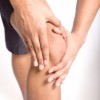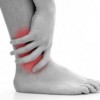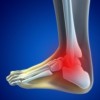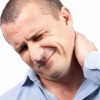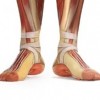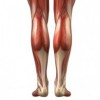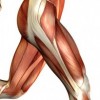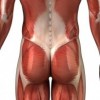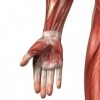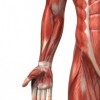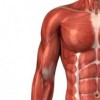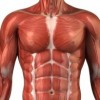Conditions
Pes anserine bursitis most commonly occurs as a result a repetitive strenuous activity that encourages the thigh muscles which attach to the lower leg, to tighten and shorten from overuse. Symptoms normally include a constant dull ache or burning pain on the inside of the knee, below the knee cap, which is aggravated by any touch, pressure or movement of the knee joint. The pain can refer to the front and back of the knee and down into the lower leg and there will normally be slight swelling around the knee.
In cases of bursitis caused by infection the skin around the affected joint will appear red and will feel incredibly warm to the touch. Additional symptoms are high temperature and feverish chills.
Peroneal tendonitis is a common injury normally seen in individuals who partake in athletic sports involving repetitive or forceful twisting of the ankle and foot to the side.
Symptoms begin as a dull ache around the outside of the ankle that gradually worsens over a course of 2-3 weeks. In some cases the discomfort will be felt on ankle eversion when the peroneal tendon is stressed and with others it is felt when resting after an activity. Stiffness and dull aches are normally experienced during the night and are most intense early in the morning. The pain and discomfort will often radiate up into the lower leg or down into the sole of the foot.
Anterior ankle impingement is a common injury and effects people of all ages. It is normally seen in individuals who partake in athletic sports that involve repetitive or forceful upwards flexion of the foot, for example running uphill or downhill, sprinting and landing from long jump.
Symptoms include intense immediate sharp pains or dull ache around the front of the ankle when flexing your foot towards your knee. Pain can be felt when simply weight bearing or when resting after an activity. Stiffness and dull aches are normally experienced during the night and are most intense early in the morning. The pain at the front of the ankle occasionally radiates up into the shin and down into the foot.
Torticollis is also known as Wry Neck or a twisted neck. There are three types of torticollis; the first is congenital muscular torticollis, the second is spasmodic torticollis and the third is acquired torticollis. The most common type is acquired torticollis which onsets suddenly over night and will be felt on waking in the morning. There will be an intense spasm on one side of the neck, so much so that the head is completely tilted towards the shoulder. Neck, upper back, arm pain and stiffness often accompany the intense neck spasm. These symptoms are normally short lived and start to ease after 24 - 48 hours.
Ankle & Foot - Myofascial Pain Syndrome (muscle pain)
Myofascial pain (muscle pain) can result from sprains or strains of a joint, excessive repetitive movements and high stress levels. Risk factors like poor posture, fatigue, heavy lifting and even muscle weakness may make you more susceptible to myofascial pain. Specific causes like stress, normally cause quite a lot of tension in the upper back and neck which can then lead to quite bad headaches.
Symptoms range from a sudden sharp pain, spasms and burning pain to a gradual build-up of a dull ache and discomfort that is worse in the evening after long days at work or activity. Muscle knots and trigger points can cause pain to refer from the injured muscle to the surrounding areas.
Lower Leg - Myofascial Pain Syndrome (muscle pain)
Myofascial pain (muscle pain) can result from sprains or strains of a joint, excessive repetitive movements and high stress levels. Risk factors like poor posture, fatigue, heavy lifting and even muscle weakness may make you more susceptible to myofascial pain. Specific causes like stress, normally cause quite a lot of tension in the upper back and neck which can then lead to quite bad headaches.
Symptoms range from a sudden sharp pain, spasms and burning pain to a gradual build-up of a dull ache and discomfort that is worse in the evening after long days at work or activity. Muscle knots and trigger points can cause pain to refer from the injured muscle to the surrounding areas.
Groin & Thigh - Myofascial Pain Syndrome (muscle pain)
Myofascial pain (muscle pain) can result from sprains or strains of a joint, excessive repetitive movements and high stress levels. Risk factors like poor posture, fatigue, heavy lifting and even muscle weakness may make you more susceptible to myofascial pain. Specific causes like stress, normally cause quite a lot of tension in the upper back and neck which can then lead to quite bad headaches.
Symptoms range from a sudden sharp pain, spasms and burning pain to a gradual build-up of a dull ache and discomfort that is worse in the evening after long days at work or activity. Muscle knots and trigger points can cause pain to refer from the injured muscle to the surrounding areas.
Low Back - Myofascial Pain Syndrome (muscle pain)
Myofascial pain (muscle pain) can result from sprains or strains of a joint, excessive repetitive movements and high stress levels. Risk factors like poor posture, fatigue, heavy lifting and even muscle weakness may make you more susceptible to myofascial pain. Specific causes like stress, normally cause quite a lot of tension in the upper back and neck which can then lead to quite bad headaches.
Symptoms range from a sudden sharp pain, spasms and burning pain to a gradual build-up of a dull ache and discomfort that is worse in the evening after long days at work or activity. Muscle knots and trigger points can cause pain to refer from the injured muscle to the surrounding areas.
Wrist & Hand - Myofascial Pain Syndrome (muscle pain)
Myofascial pain (muscle pain) can result from sprains or strains of a joint, excessive repetitive movements and high stress levels. Risk factors like poor posture, fatigue, heavy lifting and even muscle weakness may make you more susceptible to myofascial pain. Specific causes like stress, normally cause quite a lot of tension in the upper back and neck which can then lead to quite bad headaches.
Symptoms range from a sudden sharp pain, spasms and burning pain to a gradual build-up of a dull ache and discomfort that is worse in the evening after long days at work or activity. Muscle knots and trigger points can cause pain to refer from the injured muscle to the surrounding areas.
Forearm - Myofascial Pain Syndrome (muscle pain)
Myofascial pain (muscle pain) can result from sprains or strains of a joint, excessive repetitive movements and high stress levels. Risk factors like poor posture, fatigue, heavy lifting and even muscle weakness may make you more susceptible to myofascial pain. Specific causes like stress, normally cause quite a lot of tension in the upper back and neck which can then lead to quite bad headaches.
Symptoms range from a sudden sharp pain, spasms and burning pain to a gradual build-up of a dull ache and discomfort that is worse in the evening after long days at work or activity. Muscle knots and trigger points can cause pain to refer from the injured muscle to the surrounding areas.
Shoulder & Upper Arm - Myofascial Pain Syndrome (muscle pain)
Myofascial pain (muscle pain) can result from sprains or strains of a joint, excessive repetitive movements and high stress levels. Risk factors like poor posture, fatigue, heavy lifting and even muscle weakness may make you more susceptible to myofascial pain. Specific causes like stress, normally cause quite a lot of tension in the upper back and neck which can then lead to quite bad headaches.
Symptoms range from a sudden sharp pain, spasms and burning pain to a gradual build-up of a dull ache and discomfort that is worse in the evening after long days at work or activity. Muscle knots and trigger points can cause pain to refer from the injured muscle to the surrounding areas.
Chest - Myofascial Pain Syndrome (muscle pain)
Myofascial pain (muscle pain) can result from sprains or strains of a joint, excessive repetitive movements and high stress levels. Risk factors like poor posture, fatigue, heavy lifting and even muscle weakness may make you more susceptible to myofascial pain. Specific causes like stress, normally cause quite a lot of tension in the upper back and neck which can then lead to quite bad headaches.
Symptoms range from a sudden sharp pain, spasms and burning pain to a gradual build-up of a dull ache and discomfort that is worse in the evening after long days at work or activity. Muscle knots and trigger points can cause pain to refer from the injured muscle to the surrounding areas.

